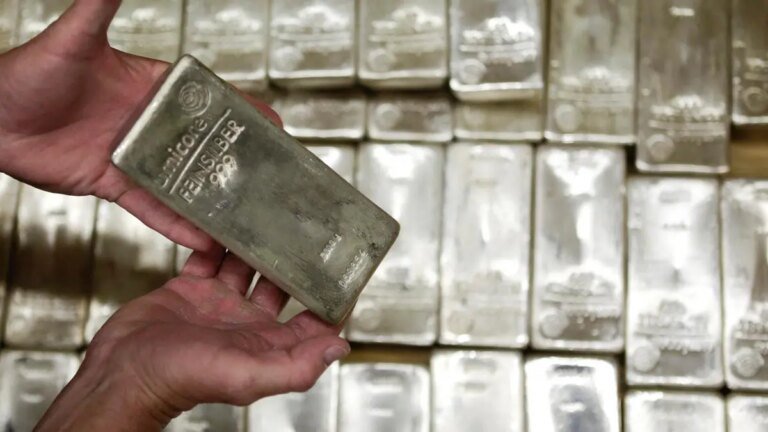
FILE PHOTO: An employee displays silver bars at the GSA Austria ( Money Service Austria ) company’s headquarters in Vienna July 22, 2013. REUTERS/Leonhard Foeger/File Photo
| Photo Credit:
Leonhard Foeger
A shortage of silver, which soared to a record $51.30 an ounce on Thursday, across the world has pushed up the premium for the precious metal exchange-traded funds (ETFs) in India by 12-14 per cent, industry experts said.
As a result, Kotak suspended subscription to its ETF Fund of Fund scheme (FoFS). Adding to consumer woes, traders are charging a premium of ₹14,000 a kg — up from ₹4,000 earlier this week.
“Bullion dealers are facing a shortage of silver and they are unable to match supply with the demand. For ETFs, the supply comes from the market makers or bullion dealers, who themselves are facing shortage,” said Satish Dondapati, Fund Manager, Kotak.

Lease rate soar
According to traders, the jump in rates of silver lease — under which silver manufacturers take the precious metal from banks and then replace it with interest — to 39 per cent from the normal 6 per cent has compounded the issue.
Venkat Chalasani, CEO, Association of Mutual Funds in India, said silver in the global spot market is being traded at $50.41 an ounce, while in the futures market it is quoted lower, which is a clear indication that there is a short supply in the market.
A similar situation prevails in India, too. “We have not seen something like this since 1980,” an analyst said. Currently, silver ETFs on the exchanges are trading at a premium, as investors are caught in FOMO (fear of missing out) phobia, said Chalasani.
On Friday, spot silver, which pared gains after hiitting record high, ruled at $50.03, while December futures contract was quoted at $48.32 at 1900 hours IST. On MCX, silver December futures ended the first session at ₹1,48,798 a kg. In Mumbai, spot silver price was ₹1,59,550.
Classic stress signs
Prithviraj Kothari, Managing Director at RiddiSiddhi Bullions Ltd and President of India Bullion and Jewellers Association Ltd, said the global silver market is showing classic signs of stress — persistent physical deficits, depleted inventories and recurring backwardation.
“This reflects a strong ‘convenience yield’, meaning immediate metal availability is highly valued amid scarcity. Historically, such tightness has led to higher spot prices, as seen during the 2010-11 rally when silver surged to $50/oz,” he said.
The current situation mirrors the 2010-11 episode: multi-year supply deficits, record industrial demand (notably from solar), and tightening visible stocks.
“However, unlike 2011, the current rally is also driven by geopolitical risk and global monetary easing. Sustained deficits could keep silver elevated, but volatility risk remains high,” he said.
Profit-booking emerges
Dondapati said the current trend will continue as supply concerns remain. “Most bullion dealers say the shortage will be there till Diwali and Dhanteras,” he said.
Renisha Chainani, head of resarch at Augmont, said silver dropped about ₹9,000 from the record high. “Thursday’s low of $46.90 (₹1,45,000) is a strong support. If silver futures sustain below this level, we could see more correction or profit booking by at least 4-5 per cent,” she said.
Dondapati said Kotak’s suspension of its ETF FoFS will continue until supply increases in the market. “The premium came down to 7-8 per cent later in the evening when some portfolio management schemes booked profit,” he said.
Kotak decided to suspend subscription to its FoFS because ETF units were trading at a premium on the exchanges and the premium could vanish once supplies improve.
Similar event during Covid
“The prevailing high premium on silver ETFs will hit investors the most once the supply starts easing after the festival season,” said Chalasani.
“Investors could lose some 8-10 per cent of their returns. We faced a similar situation during Covid when gold ETFs were traded at $60-70 an ounce premium due to non-movement of gold during the lockdown,” Dondapati said.
Once the lockdown ended and gold landed in Mumbai, the premium vanished, affecting ETF investors.
Published on October 10, 2025

